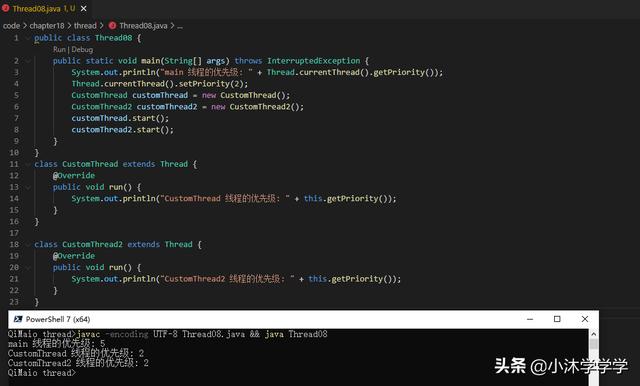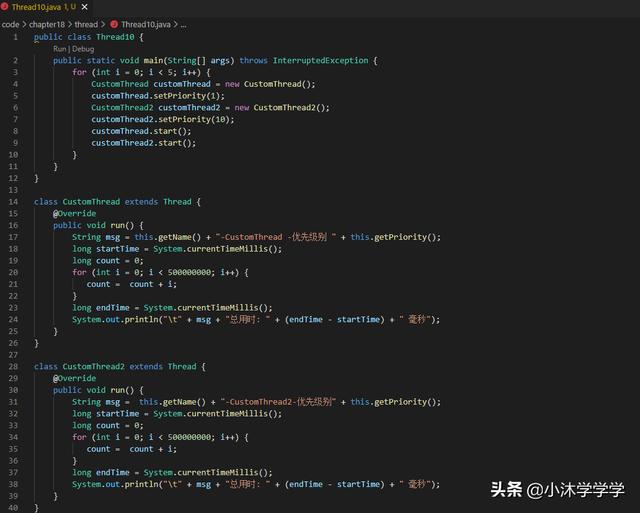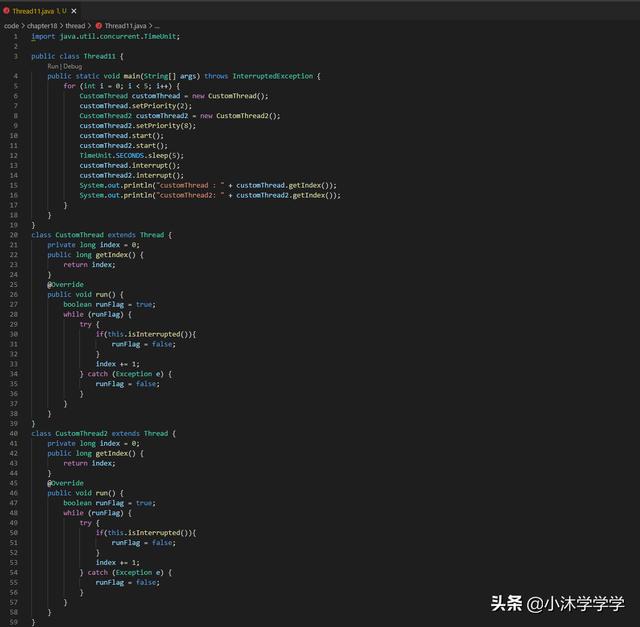Java 17 多线程 Thread 的优先级
默认优先级
Thread 中默认定义了三种优先级别,分别是: MIN_PRIORITY, NORM_PRIORITY,MAX_PRIORITY。
定义如下:
/**
* The minimum priority that a thread can have.
*/
public static final int MIN_PRIORITY = 1;
/**
* The default priority that is assigned to a thread.
*/
public static final int NORM_PRIORITY = 5;
/**
* The maximum priority that a thread can have.
*/
public static final int MAX_PRIORITY = 10;
在 Java 中 线程 的优先级分为 10 个等级,即 1~10,通过源码可以看到,如果小于 1 或大于 10,该方法将抛出异常 throw new IllegalArgument Exception ()。
if (newPriority > MAX_PRIORITY || newPriority < MIN_PRIORITY) {
throw new IllegalArgumentException();
}
可以通过以下的方法设置。
public final void setPriority(int newPriority)
演示代码如下:
System.out.println("main 线程的优先级: " + Thread.currentThread().getPriority());
System.out.println("设置 main 线程的优先级设置为 7");
Thread.currentThread().setPriority(7);
System.out.println("main 线程的优先级: " + Thread.currentThread().getPriority());

其中 Thread.currentThread() 代表着当前线程。
线程优先级具有继承特性
在 Java 中, 优先级在线程的启动运行中将被继承,比如 Thread A 线程启动 Thread B 线程,则 Thread B 线程的优先级与 Thread A 是一样的。
根据个人的使用和测试,想要继承线程的优先级,必须在创建阶段(New)前就设置优先级,否则就无法继承优先级了。
代码演示效果如下:

优先级并不绝对
虽然线程可以设置优先级,但是这个优先级并不是绝对的优先。在运行中只是 CPU 会尽量记住是尽量将执行的资源优先给优先级别比较高的线程。
用个案例演示一下:
首先定义两个线程
class CustomThread extends Thread {
@Override
public void run() {
String msg = this.getName() + "-CustomThread -优先级别 " + this.getPriority();
long startTime = System.currentTimeMillis();
long count = 0;
for (int i = 0; i < 500000000; i++) {
count = count + i;
}
long endTime = System.currentTimeMillis();
System.out.println("t" + msg + "总用时: " + (endTime - startTime) + " 毫秒");
}
}
里面的代码几乎一致,只有描述信息做了些调整,为了更方便的查看执行效果。
main 方法代码如下:
for (int i = 0; i < 5; i++) {
CustomThread customThread = new CustomThread();
customThread.setPriority(1);
CustomThread2 customThread2 = new CustomThread2();
customThread2.setPriority(10);
customThread.start();
customThread2.start();
}
完整代码如下:

查看运行效果:

可以看到优先级别比较高的可能会优先执行,或者大部分能先执行。多执行几遍,看到的效果是不一样的。本次运行的都是优先级别高的先执行了。再执行一下, 看看效果,如下图:

这里不能把运行结果的顺序和线程的优先级作为比较, 优先级别比较高,但是不代表都最先执行完,这些都是不确定以及随机性的。看 CPU 怎么分配了。
写个小例子来演示一些优先级别对结果的影响。
定义一个线程类
class CustomThread extends Thread {
private long index = 0;
public long getIndex() {
return index;
}
@Override
public void run() {
boolean runFlag = true;
while (runFlag) {
try {
if(this.isInterrupted()){
runFlag = false;
}
index += 1;
} catch (Exception e) {
runFlag = false;
}
}
}
}
复制上面的代码,定义 CustomThread2 的类。
并编写 main 方法。执行 5 次,并每次等待 5 秒钟,查看执行的数据。这里只是生成了一个索引值,一直累加 索引 值,一直到程序发起了中断。
for (int i = 0; i < 5; i++) {
CustomThread customThread = new CustomThread();
customThread.setPriority(2);
CustomThread2 customThread2 = new CustomThread2();
customThread2.setPriority(8);
customThread.start();
customThread2.start();
TimeUnit.SECONDS.sleep(10);
customThread.interrupt();
customThread2.interrupt();
System.out.println("customThread : " + customThread.getIndex());
System.out.println("customThread2: " + customThread2.getIndex());
}
完整代码如下:

代码里演示的是5秒, 这里时间越长,影响的效果越明显。

优先级的知识点, 大概就这些了。 感谢您的阅读。
每天一个新知识点。过了半个月,一个月,就是 N 个知识点了。 希望今天的你,比昨天的你更上一层楼。今天你掌握新的知识点了吗?


